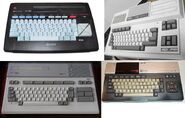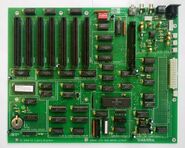| MSX | |
|---|---|
 Sony MSX, Model HitBit-10-P | |
|
Type: |
Home computer |
|
Release date: |
1983 (MSX) |
|
Discontinued: |
1995 (MSXturboR) |
|
Operating system: |
MSX-DOS / MSX BASIC |
|
CPU: |
Zilog Z80 |
|
Memory: |
16-512 KB |
MSX was the name of a standardized home computer architecture, first announced by Microsoft on June 16, 1983, conceived by Kazuhiko Nishi, then Vice-president at Microsoft Japan and Director at ASCII Corporation. The Valis series was first conceived in this computer platform with its first two games made for this system.
History[]
Originally conceived as a single industry standard for the computer market, the MSX was originally announced on 27 June 1983. Its architecture was made to compare the limitations of the Commodore and the Spectravideo (its original base). As many computers of the time, it had a variation of the programing language Basic, also from Microsoft. Among its licensed developers were Spectravideo, Philips, Al Alamia, Sony, Sanyo, Mitsubishi, Toshiba, Hitachi, National, Panasonic, Canon, Casio, Pioneer, Fujitsu General, Yamaha, JVC, Yashica-Kyocera, GoldStar, Samsung/Fenner, Daewoo/Yeno, Gradiente*, Sharp/Epcom and Talent.
The MSX spawned four generations during its active time in the market: MSX (1983); MSX2 (1986); MSX2+ (1988); and MSX TurboR (1990). The first three were 8-bit computers based on the Z80 microprocessor, while the MSX TurboR was based on an enhanced Zilog Z800 known as the R800. The MSX TurboR was introduced in 1990 but was unsuccessful due to a lack of support and the rise in popularity of the by then well-established IBM PC Compatible market. Production of the TurboR ended in 1993 when Panasonic decided to focus on release of 3DO.
In 2006, D4 Enterprise announced in August 2006 the launch of a new MSX2 compatible system called the "one chip-MSX", a system based on an Altera Cyclone EP1C12Q240C8 FPGA.
In 2011, AGE Labs announced the launch of a MSX kit called GR8BIT - the do-it-yourself computer for learning purposes, which was licensed by the MSX Licensing Corporation. The kit priced at $499 (369 euros) and includes all necessary components to assemble a working MSX2 compatible computer, except for an ATX chassis, power supply, floppy drive, hard disk, PS/2 keyboard and monitor. It also came with assembly and operational manuals and a supplement compiled from vendor and community support (from the "GR8BIT Engineering Community").
System Specifications[]
MSX (first generation)[]
- Processor: Zilog Z80A running at 3.58 MHz
- ROM: 32 KB
- RAM: 8 KB minimum, most machines provided either 32 or 64 KB; machines with 128 KB exist
- Video Display Processor: Texas Instruments TMS9918 family
- Video RAM: 16 KB
- Text modes: 40×24 and 32×24
- Resolution: 256×192 (16 colours). In reality there are just 15 colour tints available, because, just like Sinclair Spectrum there are two codes for black. Unlike the Spectrum however, one of the blacks is actually "transparent", so the MSX video picture could be overlayed on another video signal, for example one from a video disk.
- Sprites: 32, 1 colour, max 4 per horizontal line
- Sound chip: General Instrument AY-3-8910 (PSG)
MSX2[]
- Processor: Zilog Z80A running at 3.58 MHz
- ROM: 48 KB
- BIOS + Extended BIOS (32 KB)
- MSX BASIC V2.0 or V2.1 (16 KB)
- DiskROM (16 KB) (optional, common)
- MSX-Audio BIOS (32 KB) (optional, no machines are known with this BIOS built in)
- RAM: 64 KB minimum, commonly 128 KB in Europe, 64 KB on Japanese computers, machines with up to 512 KB were made
- Memory mapped (4 MB/slot max) (optional)
- Video Display Processor: Yamaha V9938 (a.k.a. MSX-Video) Supports all MSX video modes plus:
- Increased video RAM: 128 KB (sometimes 64 or 192 KB)
- New text mode: 80×24
- New bitmapped video modes without the attribute clash of MSX 1
- New resolutions: 512×212 (16 colours out of 512) and 256×212 (256 colours)
- Increased number of, and more advanced sprites: 32, 16 colours, max 8 per horizontal line
- Hardware acceleration for copy, line, fill, etc.
- Interlacing to double vertical resolution
- A vertical scroll register
- Vertical and horizontal display offset register
- Sound chip: Yamaha YM2149 (PSG)
- Clock chip: Ricoh RP5C01 (or compatible)
- 3.5 in (89 mm) Floppy disk drive was common
MSX2+[]
- Only officially released in Japan (available in Europe and Brazil via upgrades)
- Processor: Zilog Z80 compatible running at 3.58 MHz (the MSX2+ models from Panasonic can be set to run on 5.37 MHz by software, but this is not part of the standard)
- ROM: 64 KB
- BIOS + Extended BIOS (32 KB)
- MSX BASIC V3.0 (16 KB)
- DiskROM (16 KB) (optional, very common)
- Kun-BASIC (16 KB) (optional)
- Kanji ROM (optional)
- RAM: commonly 64 KB (on Japanese computers)
- Memory mapped (4 MB/slot max)
- Video Display Processor: Yamaha V9958 (aka MSX-Video) All of MSX2's specifications plus:
- The minimal video RAM is now 128 KB. Up to 192KB is supported.
- A new 256×212 YJK video mode with 19268 simultaneous colors
- A new 256×212 mixed-YJK/RGB video mode with 12499 simultaneous colors
- A horizontal scroll register
- Sound chip: Yamaha YM2149 (PSG)
- Optional sound chip: Yamaha YM2413 (OPLL) (MSX-Music)
- Clock chip RP5C01
- 3.5 in (89 mm) Floppy disk drive was very common
MSX turboR[]
- Only released in Japan
- Processor: R800 and Zilog Z80A compatible
- R800 running at 7.16 MHz (instructions use about 4x less clock ticks than the Z80, so often quoted as 28.6 MHz when comparing with the Z80)
- Zilog Z80A compatible (embedded in the T9769C MSX-Engine) running at 3.58 MHz for backward compatibility
- ROM: 96 KB
- BIOS + Extended BIOS (48 KB)
- MSX BASIC V4.0 (16 KB)
- DiskROM (16 KB)
- Kun-BASIC (16 KB)
- Kanji ROM (256 KB)
- Firmware (4 MB)
- RAM: 256 KB (FS-A1ST) or 512 KB (FS-A1GT)
- Memory mapped (4 MB/slot max)
- Additional 16 KB (FS-A1ST) or 32 KB (FS-A1GT) of SRAM (battery-powered)
- Video Display Processor: Yamaha V9958 (aka MSX-Video) so the same capabilities as MSX2+
- Sound chip: Yamaha YM2149 (PSG)
- Sound chip: Yamaha YM2413 (OPLL) (MSX-Music)
- Sound chip: PCM
- 8-bit single channel (no DMA), 16 kHz max using BIOS routines.
- Microphone built-in
- Sound chip: MIDI in/out (FS-A1GT only)
- Clock chip
- 3.5 in (89 mm) floppy disk drive




